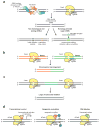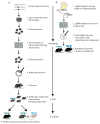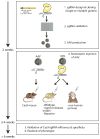Applications of CRISPR-Cas systems in neuroscience
- PMID: 26656253
- PMCID: PMC4899966
- DOI: 10.1038/nrn.2015.2
Applications of CRISPR-Cas systems in neuroscience
Abstract
Genome-editing tools, and in particular those based on CRISPR-Cas (clustered regularly interspaced short palindromic repeat (CRISPR)-CRISPR-associated protein) systems, are accelerating the pace of biological research and enabling targeted genetic interrogation in almost any organism and cell type. These tools have opened the door to the development of new model systems for studying the complexity of the nervous system, including animal models and stem cell-derived in vitro models. Precise and efficient gene editing using CRISPR-Cas systems has the potential to advance both basic and translational neuroscience research.
Figures




References
-
- Lewis EBBF. Methods for feeding ethyl methane sulphonate (EMS) to Drosophila males. Drosoph Inf Serv. 1968;43
-
- Fire A, et al. Potent and specific genetic interference by double-stranded RNA in Caenorhabditis elegans. Nature. 1998;391:806–11. - PubMed
-
- St Johnston D. The art and design of genetic screens: Drosophila melanogaster. Nat Rev Genet. 2002;3:176–88. - PubMed
-
- Jorgensen EM, Mango SE. The art and design of genetic screens: caenorhabditis elegans. Nat Rev Genet. 2002;3:356–69. - PubMed
-
- Patton EE, Zon LI. The art and design of genetic screens: zebrafish. Nat Rev Genet. 2001;2:956–66. - PubMed
Publication types
MeSH terms
Grants and funding
LinkOut - more resources
Full Text Sources
Other Literature Sources

